ALLIES DENOUNCE NAZI KILLING OF JEWS
Washington, D.C. and London, England • December 17, 1942
In remarks he made to 14 senior Nazis at a top-secret conference in the fashionable Berlin suburb of Wannsee on January 22, 1942, 38‑year-old SS-Obergruppenfuehrer Reinhard Heydrich, chief of the Reich Security Head [or Main] Office as also head of the German secret police apparatus, spoke of “practical experience” that was being collected “in relation to the future Final Solution of the Jewish problem.” Six in Heydrich’s audience were fellow SS officers who, like the speaker, already knew a thing or two about the “Jewish problem.” Other attendees were state secretaries and undersecretaries of the German Foreign Office, the ministries of the Interior, Justice, and Economics, and the so-called General Government in Nazi-occupied Poland. Eight of the dignitaries held doctorates.
The minutes of the hour-and-a-half meeting, as recorded by SS-Obersturmbannfuehrer Adolf Eichmann and edited by Heydrich himself, contained the expression “evacuation of Jews to the East” (“Evakuierung der Juden nach dem Osten”), a euphemism, as Eichmann later testified, that meant the genocidal killing of all European Jews that fell under Nazi domination. Europe, Heydrich told his listeners, would be “combed” of Jews from west to east. “Approximately 11 million Jews will be involved in the final solution of the European Jewish question (Im Zuge dieser Endlösung der europäischen Judenfrage kommen rund 11 Millionen Juden in Betracht),” read the Wannsee minutes.
As the year wore on, the body of experience Heydrich referred to was put to practical use in 6 major killing centers that operated in German-occupied Poland: Bełżec, Sobibór, Treblinka, Majdanek, Auschwitz-Birkenau, and Chełmno. At these places gas chambers using German industrial giant I.G. Farben’s cyanide-based Zyklon B or simply carbon monoxide destroyed millions of Jewish lives.
On this date, December 17, 1942, Allied governments issued a formal condemnation of the “German Policy of Extermination of the Jewish Race.” This declaration became imperative because of credible reports since mid-1942 that Germans had turned from persecuting and “resettling” Jews in the East to systematically murdering them on an industrial scale. The Allies’ declaration was a stark recognition that it was Nazi Germany’s “intention to exterminate the Jewish people in Europe.” The Allies condemned “in the strongest possible terms this bestial policy of cold-blooded extermination.” Read aloud in the British House of Commons by Foreign Secretary Anthony Eden and in Washington, D.C., by President Franklin D. Roosevelt himself and appearing on the front page of the New York Times and elsewhere, the statement claimed that the “infirm [were] left to die of exposure and starvation” or were “deliberately massacred in mass executions,” the hundreds of thousands of victims “entirely innocent men, women and children.” The statement affirmed that the perpetrators “shall not escape retribution.” It was the first and the strongest public condemnation of atrocities against European Jews that the Allies issued during World War II. Notwithstanding their government’s conclusion, most Americans as late as 1943 either believed that the reports of mass killings in Eastern Europe were greatly exaggerated or had no opinion about their accuracy. But the fact remains—1942 was the most lethal year in Jewish history: 2.7 million Jews lost their lives, a little less than half the number killed during the entire war.
The Holocaust in Eastern Europe
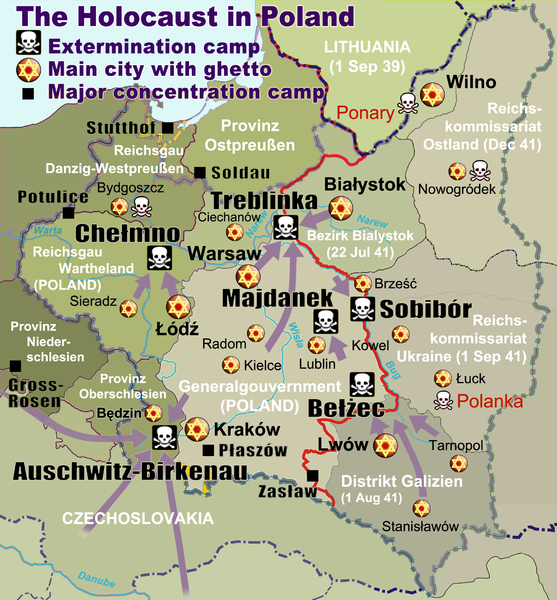 |
Above: The estimated total number of people killed in the extermination camps in the East is over three million: Auschwitz-Birkenau (Poland), 1,100,000; Bełżec (Poland), 600,000; Chełmno (Poland), 320,000; Majdanek (Poland), 360,000; Sobibór (Poland), 250,000; Treblinka (Poland), 700,000–800,000; Maly Trostenets (Belarus), 65,000; and Jasenovac (Croatia), 85,000–600,000.
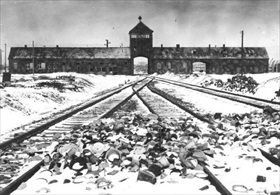 | 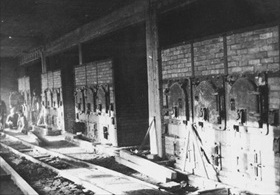 |
Left: Photo of Birkenau (the extermination camp at Auschwitz) following the camp’s liberation on January 27, 1945. In the foreground amid the rubble is the unloading ramp (the so-called Judenrampe) and in the distance Birkenau’s main gate called the “Gate of Death.” In the most systematic, sustained genocide in history, transport trains from spring 1942 until fall 1944 delivered Jews from all over Nazi-occupied Europe to the gas chambers of Auschwitz-Birkenau. Beginning in 1942, Auschwitz-Birkenau became the largest of the Nazis’ death camps.
![]()
Right: Gas ovens in Birkenau crematory II. The picture was taken by the SS right before finishing the building in June or July 1943.
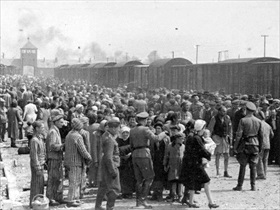 | 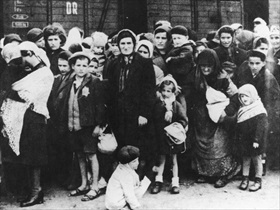 |
Left: Hungarian Jews on the Judenrampe in Auschwitz-Birkenau after disembarking from transport trains. Being directed rechts! (to the right) meant camp labor. Sent links! (to the left) meant the gas chambers at Birkenau.
![]()
Right: Hungarian Jewish mothers, children, elderly, and infirm sent links (to the left) after “selection,” May 1944. They would be murdered in Birkenau’s gas chambers soon thereafter.
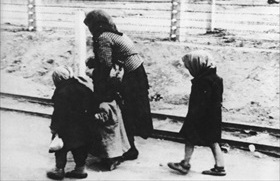 | 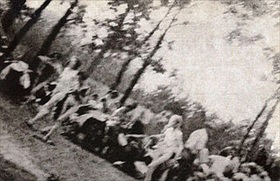 |
Left: Hungarian Jewish children and an elderly woman on their way to the Birkenau gas chambers, May 1944. Many of the very young and very old were murdered immediately upon arrival and were never registered by camp officials.
![]()
Right: In August 1944 members of the Auschwitz-Birkenau Sonderkommando managed to secretly photograph the extermination process of undressed women prisoners. Sonderkommandos were work units of death camp prisoners, composed almost entirely of Jews, who were forced on threat of their own deaths to aid in the disposal of gas chamber victims.
History Channel Documentary: Auschwitz, the Forgotten History (Part 3, To the Gas Chambers)
![]()

 History buffs, there is good news! The Daily Chronicles of World War II is now available as an ebook for $4.99 on Amazon.com. Containing a year’s worth of dated entries from this website, the ebook brings the story of this tumultuous era to life in a compelling, authoritative, and succinct manner. Featuring inventive navigation aids, the ebook enables readers to instantly move forward or backward by month and date to different dated entries. Simple and elegant! Click
History buffs, there is good news! The Daily Chronicles of World War II is now available as an ebook for $4.99 on Amazon.com. Containing a year’s worth of dated entries from this website, the ebook brings the story of this tumultuous era to life in a compelling, authoritative, and succinct manner. Featuring inventive navigation aids, the ebook enables readers to instantly move forward or backward by month and date to different dated entries. Simple and elegant! Click 











